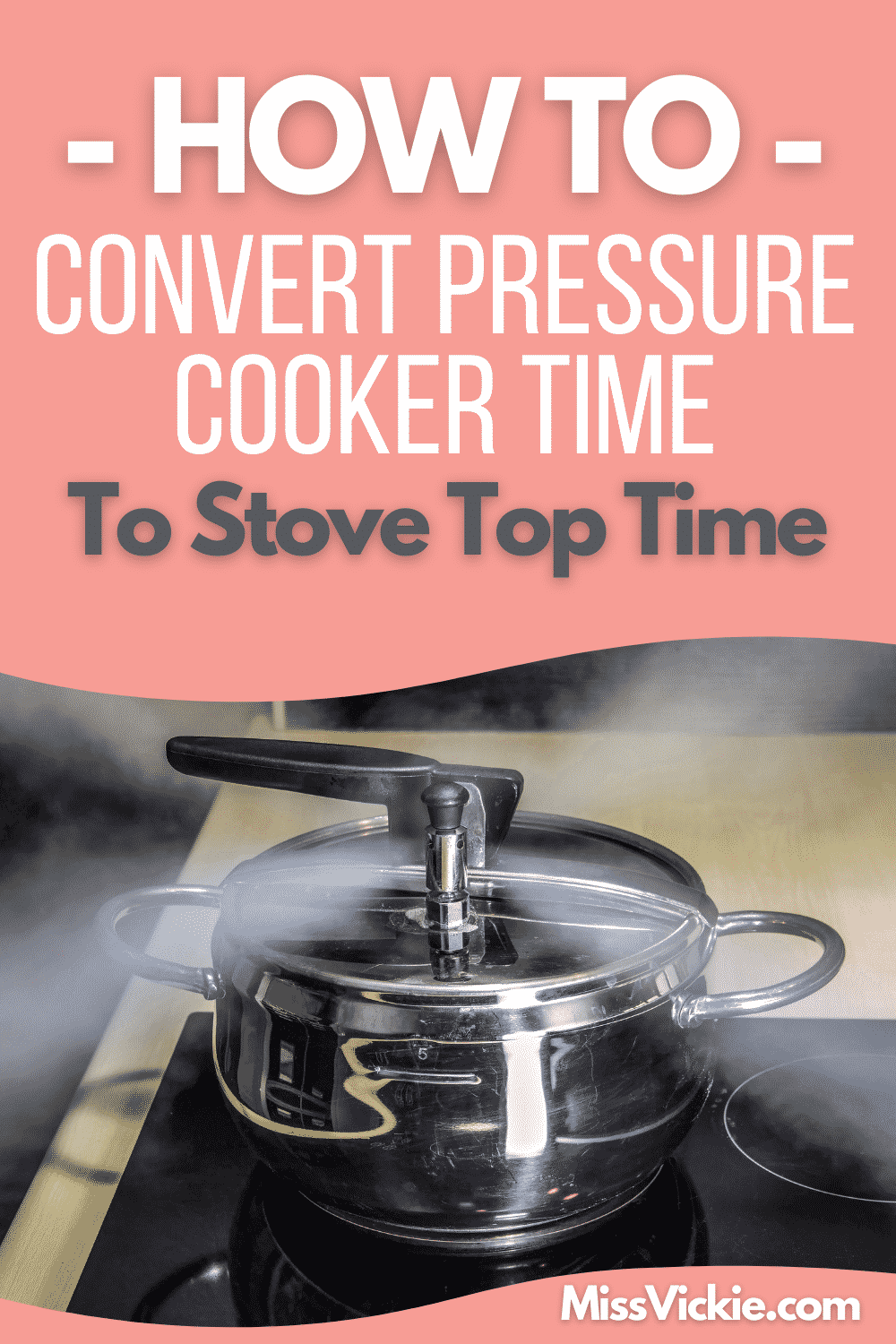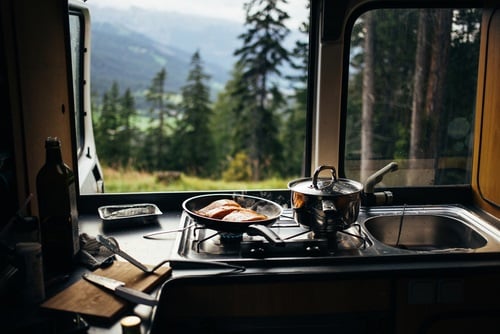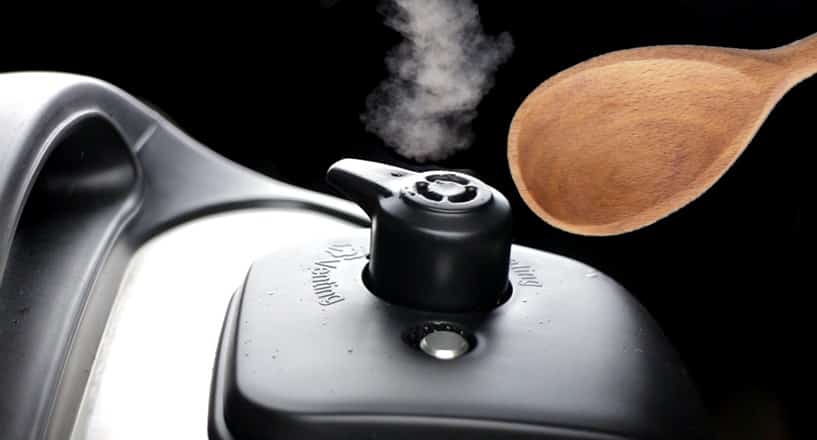
Converting your repertoire of special recipes that have guided you for years of pressure cooker use can be a little daunting.
Alternatively, you might need to cook something on the stovetop but only have the pressure cooker recipe and directions.
Most people manage to convert the ingredients such as liquids but struggle with the cooking times. Converting pressure cooker time to stovetop time (and vice versa) can be tricky, especially if you are new to pressure cooking.
Convert Pressure Cooker Time To Stove Top
We’ve put together a few simple guidelines. Follow them, and you’ll easily be able to convert your favorite recipes to the pressure cooker.
1. Add water
The overriding principle is that you must have at least one cup of liquid. One and a half cups are better.
You can look in your pressure cooker’s manual for the liquid requirement for your model.
That’s because the pressure cooker will not be able to work without this amount of liquid. The machine requires it to build up the pressure.
Of course, because the pressure cooker is a sealed unit, there is little evaporation. You may end up with more liquid in your finished dish than you would like.
This isn’t a problem though, because you can always strain it off then reduce it over high heat until you are happy with the quantity of sauce or gravy in the end.
Convert water needed when cooking on Stove Top:
Pressure Cooker to Stove Top Ratio: 1: 2 or more
If you are cooking on the stovetop, the water evaporates quickly and you need to add more water. (No fixed ratio, depending on what type of food you are cooking, always monitor your water level during cooking to avoid burned food)
2. Alter the cooking time
The next step is to cook the dish for one-third of the time called for in the original recipe when you cook in a pressure cooker.
After cooking, use the correct pressure release method for whatever you are cooking.
For instance, bigger cuts of meat like pot roasts or whole poultry, dried beans, soups, or other dishes that require a large amount of liquid will be better if you use natural pressure release.
Convert Time needed when cooking on Stove Top:
Pressure Cooker to Stove Top Ratio: 1: 3
Cooking on a stovetop requires 3 times longer than cooking using a pressure cooker

3. Know what you are cooking
Before converting times, it’s also important to understand that you can’t cook everything in a pressure cooker.
Fried foods such as fried chicken, breaded meats, steaks, or dairy-based recipes are not suitable for pressure cooking, so you will need to cook these in a conventional way (unless your pressure cooker has an air fryer function).
However, anything you can cook in a liquid such as soups, casseroles, or pasta dishes can be cooked in a pressure cooker.
Some egg dishes are also suitable, except for fried eggs, of course.
4. Pressure cooking is, of course, faster
To convert pressure cooker time to stovetop time, you can roughly expect that using the pressure cooker for meats and vegetables should take about 3 times faster than if you cooked them on the stovetop.
For example, a pressure cooker recipe that takes 20 minutes cooking time on high pressure will now take an hour on the stovetop. (20 minutes x 3 = 60 minutes)
Pressure cookers are great for enabling you to produce slow-cooked tasting tender dishes in a fraction of the time it takes to cook a casserole or stew, for example, on the stovetop.
Cooking these types of dishes on the stovetop is more time-consuming and does not give an improved flavor overcooking under pressure. It also uses more electricity because of the longer cooking time.
5. Watch your altitude

Another thing to bear in mind when converting your times is that liquids boil at a lower temperature at a high altitude. Altitude also affects a pressure cooker’s pressure.
When using one at a high altitude, you will need to increase your cooking times by 5% for every 1000 feet over 2000 feet above sea level.
A pressure cooker is always more convenient!
Many people use the pressure cooker for pasta dishes. In reality, cooking pasta in a pressure cooker does not really save you much time, so it makes no difference whether you cook on the stovetop or under pressure.
For example, if the packet’s directions advise that you need to cook pasta for 12 minutes on the stovetop, you can generally cook the same pasta for 4 minutes under high pressure.

However, you will need to use natural pressure release (NPR) once the cooking time is over, which may take around 5 minutes.
Cooking pasta under pressure is more convenient, according to many pressure-cooking fans, but it only saves you around 3 minutes.
That said, results are usually better, and you do not have to watch the pot or worry about it boiling over, as you do with conventional stovetop cooking.
An added advantage of cooking under pressure is that you can cook directly from frozen, so you don’t have to factor in the time it takes to defrost your ingredients by leaving out or using the microwave.
In general, you only need to add a couple of minutes of cooking time when cooking frozen food.
As the pressure cooker won’t come up to pressure until the ingredients are thawed out, you don’t have to make any additional cooking time calculations.
To sum up, remember that the pressure cooker cooks everything faster, so if you are trying to convert cooking time to stovetop time, you will need to multiply cooking times by three.
If you’re converting a recipe for the first time, we advise that you cook it for a little under time to make sure that you don’t overcook the food.
You can always put it on for a little longer if necessary, but if it’s overdone, there’s nothing you can do about it.